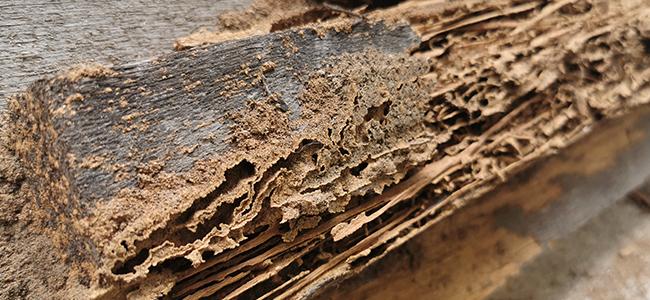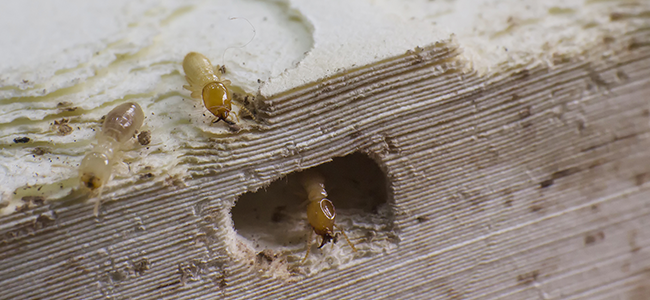
What Every Radford Resident Should Know About Termite Control
01/17/2022
Find out what you need to know about termite control in Radford. ...
READ MORE >

Some words automatically have a negative connotation, and the word termite is one of them. Termites have earned their bad reputation, but the majority of people probably don’t understand how destructive termites can be and how dangerous it is when they get into your home. In order to win the fight against termites in your Maryland home, it helps to learn a little more about these wood destroying insects.
You may think of termites as lowly insects without a lot in the way of intelligence, but the truth is their colony is set up in an organized fashion that maximizes productivity. The more you learn about how they work, the more fascinating these destructive pests become.
Termites live within a caste system. As it relates to the insect world, the word caste describes divisions within a species, where each group has marked physiological differences and performs certain roles within the larger group. The termite caste system is made up of three main groups- workers, soldiers, and reproductives - with the reproductive group having several subgroups of its own.
The worker termite group is the largest of the three castes and they have the important job of keeping the entire colony running smoothly. Worker termites are in charge of many tasks, including gathering food for themselves and the termites in the other castes, taking care of the younger members of the colony, taking care of the eggs, building and maintaining the nest and tunnels, and getting rid of the deceased members of the colony.
Worker termites remain within the colony for their entire lives, which typically last one to two years, never venturing out in the open. Their bodies remain soft, and they have no eyesight which makes them well-suited for their dark, moist environment. Although worker termites are sterile, they do have the ability to further their own development. If something threatens the well-being of the colony, worker termites can change into soldiers or reproductives to maintain the overall balance of the termite community.
The soldier termite caste is much smaller than that of the worker termites. As their name indicates, soldier termites are tasked with protecting the colony. This mainly requires them to stand guard at the entrances and exits of the nest to ensure that no intruders make it inside. They do this through the use of their strong oversized jaws and by excreting a sticky white substance to impede intruders.
Like the worker termites, soldier termites are sterile, blind, and live one to two years. However, they are slightly larger than worker termites and have bigger jaws. They are incapable of feeding themselves and thus leave that task to one of the worker termites.
The reproductive caste is a bit more complicated than the worker and soldier castes. Each termite colony has only one true king and queen. These two are the main reproductive members of the colony. The queen’s only job is to produce eggs, and a large queen at her peak can lay over 1000 eggs each day. Unlike workers and soldiers, whose lifespan is quite short, a king and queen pair can live up to 50 years.
However, the king and queen are not the only reproductive members of the colony. Termites known as alates are the young reproductive termites in the colony. These termites have eyes and wings, and their bodies are made to withstand the outside air. When alates reach maturity, they leave the nest in a swarm, which is why they’re sometimes referred to as swarmer termites instead of reproductive termites.
Once outside, they find a mate, then discard their wings. At this point, they become known as de-alates, and they begin the work of forming their own new colony. At first, they are responsible for caring for eggs independently and thus only lay a few at a time. However, once they have some worker and soldier termites in place to help, they’ll begin to ramp up their reproductive efforts.
Beyond the king, queen, alates, and de-alates in the reproductive caste, there are also secondary reproductives. These termites, like workers and termites, cannot see and do not have wings. Their primary job is to assist the queen in laying eggs when her productivity begins to decrease. When the queen dies, one of these termites will take her place which ensures the continuity of the colony.
You’d think that with a queen termite laying up to 1000 eggs per day, it would be fairly easy to determine that a termite colony has gotten into your house. After all, with those kinds of numbers, a termite colony will quickly grow. Certainly you’d notice if hundreds of thousands of insects were living in your walls, right? Unfortunately, the answer to that question is, not necessarily.
Termites do not make a lot of noise, so even when there are a lot of them in your home, you’re unlikely to hear them moving around. Furthermore, most of them never see the light of day, so you won’t see them crawling around on your countertops or floors either. So how can you identify a termite infestation in your Maryland home? There may be subtle signs.
Mud tubes are another sign of a termite infestation. As mentioned previously, most termites never come out in the open, and their bodies are not able to withstand light or dry air. When it’s necessary for them to move from a place in the soil to a different location- for example, inside your home- they sometimes build pencil-width tubes out of mud. You’re most likely to see these mud tubes outside along your foundation walls and inside along your basement walls.
Termites are tidy creatures and like to keep their waste outside of their colony. Therefore, you can often determine their presence by looking for their droppings. Termites keep their tunnels clear by pushing their waste, called frass, out of the tunnels’ openings. If you find tiny holes in wooden structures in your home with a sawdust-like substance below them, there’s a good chance you have a termite problem.
Worker termites spend a lot of their time building tunnels, which are also called galleries. These are primarily dug inside of a piece of wood, making them nearly impossible to see. However, as termites create more and more tunnels over time, these tunnels create grooves which become visible along the edges of wood. The easiest place to check for this type of damage is outside where wooden structures have direct contact with the soil. Try digging up a fence post to see if there are any signs of galleries. If you find some, you can be sure that a termite colony is at work.
If termites go undetected long enough, they will start causing noticeable damage to your house. When wooden structures become too weak, you’ll start to see your walls begin to bulge out, your ceilings begin to sag, and your floors begin to buckle. Furthermore, if doors and windows become difficult to open and close, it could be the work of termites.
If you’ve read this far, you’ve probably begun to understand why a termite infestation can be so devastating to a home. Thousands upon thousands of pests eating away at your house day after day are a cause for alarm. But just how destructive are these wood destroying insects?
Statistics show that termites cause over $5 billion in structural damage to US properties every year. Since termite damage is usually not covered by homeowners insurance, this leaves individual homeowners financially responsible for repairs.
Termites are present in 49 of the 50 states, so it’s not a matter of if you’ll have an infestation as much as it is when they’ll invade. Early detection will help you eliminate a colony in its earlier stages of formation and thus decreases the damage done to your home. If a young colony has the opportunity to grow into a well-established one, it can make a house structurally unsound in a matter of just a few years. Despite all of the financial and emotional hardship a termite colony will cause, more than half of American homeowners have never had a termite inspection done by a certified professional.
Now that you understand how termites work and grow, and how utterly destructive they can be in a short amount of time, the next logical question is: How you can avoid a termite infestation in your Maryland home? Thankfully, the answer to this question is simple. When it comes to termites, you must have a system in place that not only eliminates any termites currently in or around your home, but that also works 24/7 to keep them away from your house.
American Pest has been a certified installer and maintainer of the Sentricon® System with Always Active™- the Number 1 brand in termite protection- for over 20 years. Sentricon® with Always Active™ is a termite baiting system that is scientifically proven to be more appealing to termites than your home’s wooden structures. Once the worker termites take the bait, they’ll not only eat it themselves, but will bring it back to the soldiers, the reproductives, and the king and queen, eventually eliminating the entire colony.
The service technicians at American Pest have the training and experience necessary to implement the Sentricon® System with Always Active™. When you choose American Pest for your termite control needs, we’ll first do a thorough inspection of your home to look for signs of an active infestation. Next, we’ll install the bait stations in regular intervals around the perimeter of your house, which will provide immediate protection against termites. After detection and implementation, we’ll continuously monitor and maintain the stations, looking for any signs of termite activity in order to keep your home protected year-round.
Partnering with American Pest to protect your Maryland home from termites is a smart decision. Not only will you potentially save yourself thousands of dollars in repair costs, but you’ll also be working with a team that has the experience and expertise to ensure your home remains protected from the many threats that termites bring. Termites may be fascinating creatures, but that doesn’t mean you want them anywhere near your home. Contact the professionals at American Pest today to keep your home and family safe from termites!

01/17/2022
Find out what you need to know about termite control in Radford. ...
READ MORE >

12/17/2021
Termites can cost you thousands of dollars in repairs. Find out what termite damage looks like in Virginia homes, as well as how to avoid it, by re...
READ MORE >

10/20/2021
What's yellow and white and orange all over? None other than these sneaky insects with a penchant for wooden objects! ...
READ MORE >

08/20/2021
What has six legs, two antennae, and insatiable hunger for wooden items in your home? If you said termites, you'd be right!...
READ MORE >

Protect your home and family from nuisance and potentially damaging pests with a Preferred Care home pest control plan. Starting at $49/month

Don't let the bed bugs bite a second longer. Contact American Pest for the most comprehensive bed bug control in the industry. Learn More

Our certified rodent control pros will put an end to your frustration by getting rid of rats and mice inside your home. Learn More

Say goodbye to wood-destroying termites in your home when you contact American Pest for expert termite control. Learn More

Trust American Pest to deliver professional backyard tick control services that are guaranteed to get results. Learn More

Don't spend the warm-weather season indoors, find out how American Pest's professional treatments get rid of mosquitoes. Learn More
Fill out the form and recieve feedback in less than 5 minutes. For immediate service please call.